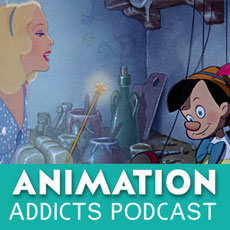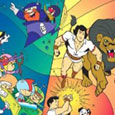Belvision/Universal Studios (December 22, 1965), Image Entertainment (April 15, 2003), single disc, 70 mins plus supplements, 1.78:1 anamorphic widescreen, Dolby Digital 2.0 Mono, Rated G, Retail: $9.99
Storyboard:
Pinocchio becomes a wooden boy again due to misbehavior, but has the opportunity to redeem himself when he decides to go into space to face Astro the Space Whale.
The Sweatbox Review:
Fred Ladd is best known for being involved in the packaging of Japanese anime for North American audiences, going way back to the days of Astro Boy, Kimba, The White Lion, and Gigantor. At about the same time that he was involved in those efforts, however, he was also co-writing (as “Fred Laderman”) and producing a somewhat bizarre feature called Pinocchio In Outer Space. Joining him in this venture was Norm Prescott, well known for being a producer at Filmation. The general story was Prescott’s, and he served as co-producer on the film. As Ladd describes in his commentary, Pinocchio In Outer Space utilized artists from all over Europe. They came to bolster the staff in Brussels, Belgium, the headquarters of the Belvision studio contracted to do the animation. (Universal Studios handled distribution upon release.)
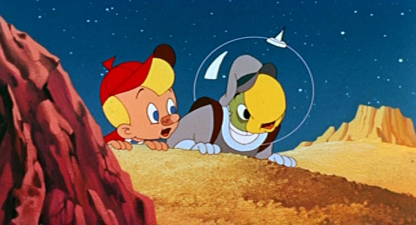
The object of the film was for it to be both a sequel to the original Collodi tale, as well as a modern-day update, complete with an element of science fiction. Thus, Pinocchio had already become a real boy, but he lost his humanity again by misbehaving. The whale this time is a giant rogue Space Whale, possibly a mutant from Mars. And Pinocchio’s companion, rather than some quaint cricket, is an alien turtle-like being with the voice of Arnold Stang (Top Cat). Now, thanks to Image Entertainment’s April 2003 release, animation buffs can see for themselves what an odd little film this is.
In Pinocchio In Outer Space, the first characters to be introduced are the Blue Fairy and her mom, knitting in space as satellites and spaceships fly past. The Blue Fairy recounts for her mother how she turned Pinocchio into a real boy, only to see him returned to his original pulpy complexion. Our attentions then turn to Earth, where Geppetto is talking to Pinocchio while watching television reports of Astro the Space Whale. It is obvious at this point that the film has a contemporary setting! Astro has been terrorizing the spaceways, apparently, and lately he destroyed a new rocket. Scientists are baffled as to his origins or how to stop him.
Pinocchio, feeling bad that he has yet to give the Blue Fairy a good reason to turn him back into a boy, as well as wishing that he and Geppetto did not have to live in poverty, conceives of a plan. He will stop Astro! …Somehow.
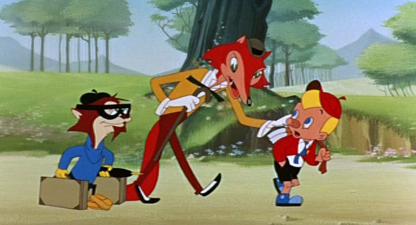
On his way to school, Pinocchio is accosted by the Fox and the Cat, here named Sharp and Groovy respectively. Sharp comes off as a used car salesman type, while Groovy is something of a beatnik. They hoodwink Pinocchio into purchasing a book describing the art of hypnotism. Despite hearing from his conscience on the subject, Pinocchio spends his only money on the book, planning to learn how to hypnotize the giant rogue space whale.
As Pinocchio wanders away while reading his new book, a spaceship comes down to Earth, and its sole occupant approaches our young wooden hero. The alien creature is Nurtle the Twurtle, who is not a turtle, but is in fact a secret agent who has been sent to find the source of some strange radiation. This seems to have something to do with Astro, so Pinocchio informs Nurtle of his ability to capture the whale, and the two go off on an adventure that takes them to Mars. There, they encounter strange creatures and much danger before finally encountering Astro…

Okay, so whose idea was this kooky tale??!! (Yes, I know that I already said it was Norm Prescott’s. You know what I mean.) As you can see by the above summary, this is a bizarre take on the classic puppet-boy. For me, that alone made this movie worth a look. I enjoy retellings of fairy tales, and the sci-fi element had me sold on at least giving this one a try. Any animation team that could try to work with such a surreal story deserves to have their film considered. Ah, but is it any good?
Somewhat surprisingly, yes, it’s not too shabby. That may seem like faint praise, but I would rank this in a similar fashion as the lesser Disney animated classics. Young kids probably wouldn’t mind watching it, but they also probably wouldn’t want to view it repeatedly like they might The Lion King. The story, for all its loopy qualities, is fairly straightforward and well told. The violence that occurs on Mars is relatively mild by today’s standards, but does contribute a nice sense of intensity and true danger that helps to draw adults more into the movie. The animation is bright and bouncy if not spectacular, and even the songs are decent little ditties. The collector in me bought this DVD, but the cartoon fan in me enjoyed it.

Is This Thing Loaded?
And here’s another example of how Image didn’t just dump this disc on the market. They have actually put together a nice little set of features, more than I expected certainly. First up is an Audio Commentary by Fred Ladd, where he discusses how the film’s production lasted from 1960 to 1964, the work of the European artists, and various story choices. Most impressive is how he manages to describe, without a hint of irony in his voice, how scientifically accurate the events in the movie are. I know, he is referring to things like Mars’s lighter gravity and the depiction of rockets, but it is funny to hear about the validity of science being present in a movie about a wooden boy flying through space with a talking turtle. Would you believe that the film’s Technical Supervisor was none other than Martin Caidin, who is likely the same aeronautics enthusiast who authored the book Cyborg, on which The Six Million Dollar Man was based! All in all, it’s a good commentary track, which like the film is short enough that it does not wear out its welcome.
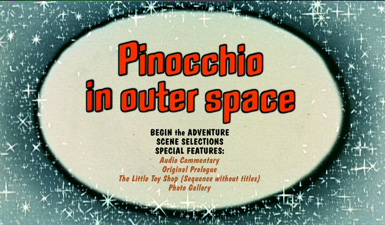
The film’s Original Prologue runs six minutes, offering an erudite view of our solar system and space travel, all reportedly factual. There is little animation here, relying instead on NASA footage, and models of planets and a space probe. Radio actor Brett Morrison provides narration, as he still briefly does in the final film. It is great to see this extra being included on the DVD, as it is a fascinating find, but ultimately it was a good choice to drop it from the picture. This is basically a kiddie flick, and the overly serious tone of the prologue, as well as its near-absence of animation, made it a weak fit for the rest of the film. The Prologue also gets its own Audio Commentary by Ladd, in which he again emphasizes the scientific accuracy of the proceedings. The video on this segment is in far worse shape than the finished feature, with numerous indications of its age such as dirt and scratches. However, it is shown in anamorphic widescreen just like the feature.
The original artists on the movie may appreciate this next feature the most. In the film, the movie’s opening credits run over a sequence showing the shelves in Geppetto’s workshop. The Little Toy Shop Sequence Without Credits allows viewers to better appreciate the artwork that the credits were covering up.

Lastly, a Photo Gallery runs for a minute with a song from the film playing in the background. Included are character sketches, storyboards, staff shots, and movie posters and lobby cards. There are some nice pieces in there, but they run a bit fast, and the “Pause” function from the remote has been inexplicably disabled. I like the idea of not having to press the Step button over and over again, but don’t kill my “Pause” button! It is a little frustrating, but at least this feature is short enough that it can be watched again without wasting too much time.
Case Study:
Standard keepcase with insert listing chapter stops.
Ink And Paint:
Well, surprise, surprise! Image has given us an anamorphic 1.78:1 transfer of this movie, resisting the temptation that other studios succumb to when they make full screen DVD’s of their children’s films. There is more good news— a very good job was done with the video compression, resulting in the absence of haloing or compression artifacts. The less-good news is that the film does show its age. The DVD may give an accurate view of the film elements, but the elements were not perfect. There are about as many imperfections as one might expect, with a modest amount of marks and scratches present. Given that this movie was unlikely to receive a full digital restoration, I was more than satisfied with the presentation overall. After all, this movie is coming on forty years old, and this is an obscure title. Most will be pleased with the sharp, vibrant colors and solid transfer present.

Looking more closely at the animation, I will just comment that it is smooth and professional, impressing me more than I expected. The character design is from the warm & cuddly school, with all the characters appearing round and appealing. The designs are unique and yet follow the ideas of cartooning that predominated in the middle part of the century on both sides of the Atlantic. There is true personality animation here, although the effect is more gentle than wacky. The color palette is pleasingly warm, with a nice diversity seen in the backgrounds. It does take getting used to seeing Pinocchio with blonde hair, however.
Scratch Tracks:
This is a two-channel mono track, and it is perfectly fine. For the most part, this sounds as good as a simple modern TV show, except perhaps for the musical numbers having a hint of distortion. Speaking of the songs, they are all consistently chipper and enjoyable. Given that the choice was made to have songs in the first place, the ones that found their way into the picture are quite pleasant without being cloying or overly sentimental.
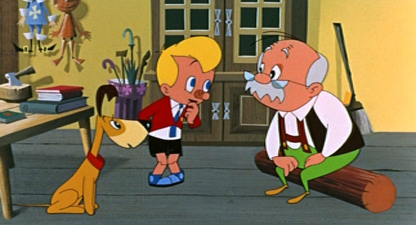
Final Cut:
If you can be open-minded about a blonde Pinocchio in an outer space setting, you will likely find some enjoyment with this disc. The movie may not be a classic for the ages, but this is a well-done and rarely seen cartoon. Quality-wise, I kept thinking of Disney’s The Sword And The Stone, another good but not great example of an animated film. Image Entertainment has prepared a better disc than the movie probably deserved, making it even easier to recommend at least considering picking this one up. I suspect that many true-blue toon buffs will at least appreciate seeing this obscure movie made available on our favorite format.
 | ||
 |







